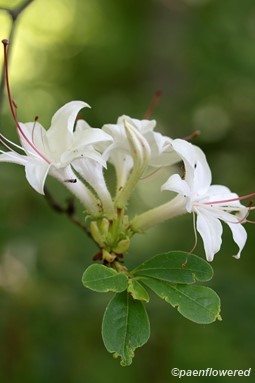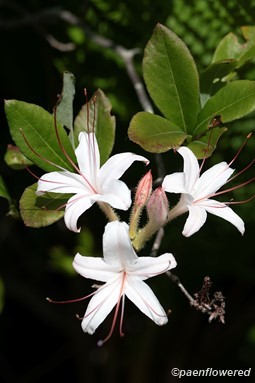Rhododendron arborescens
Rhododendron arborescens smooth azalea
Smooth azalea or sweet azalea is a fast-growing, deciduous shrub producing white to pink-tinged clusters of flowers in late spring or early summer. The fragrant, terminal inflorescences bear 3 to 7 funnel-shaped flowers, each measuring 1 to 1¾ inches across, and appearing after the leaves have emerged. Protruding well beyond the petals are 5 showy red stamens.
The shiny green leaves are 1¾ to 3 inches long, ovate, obovate, or elliptic in shape; the undersides are whitened and waxy, glabrous except for leaf margins that are fringed with fine hairs.
This lovely shrub is native to the Eastern United States. It thrives in moist, acidic soil, along streams, woodlands or areas with partial shade. It grows as a shrub or small, branchy tree 8-12 feet tall with an equal spread. It is one of the hardiest and fastest growing azaleas and last to bloom in the spring.
Insects such as aphids, borers, lacebugs, thrips, leafhoppers, and whiteflies can affect azaleas, including smooth azalea. Diseases such as root rot, powdery mildew, and leaf spot are also common concerns. Rhododendron arborescens contains toxic compounds (grayanotoxins) and should not be ingested by humans or animals, as it can cause serious poisoning.
Habitat & Range
Occasonal in woods, thickets, and stream banks. Prefers full to partial shade and moist, acidic, sandy soil.
See distribution map at BONAP.
Range: Native to the Eastern United States, primarily within the Appalachian region, where it grows in parts of Pennsylvania, West Virginia, Kentucky, Tennessee, North Carolina, South Carolina, Georgia, and Alabama.
| EMP: | FAC |
|---|---|
| NCNE: | FAC |
Phenology
Flowers May to early June. Flowers appear after the leaves.
Characteristics
Inflorescence terminal cluster of 3 to 7 funnel-shaped flowers
Flowers funnel-shaped, tube with gland-tipped hairs; corolla white to pink-tinged; 5 red stamens protruding beyound petals; pedicels with long hairs or glabrous; 1 to 1¾ inch across
Leaves alternate, simple, dark green, glabrous or nearly so beneath; often whitened; ovate, obovate or elliptic; 1¾ - 3″ long
Stems slender, erect, yellowish-brown; smooth-textured, becoming slightly ridged with age
Fruit dehiscent, narrow, 5-celled capsule; with gland-tipped hairs; numerous tiny seeds, lack loose, expanded testae; ¾″ long
Bark smooth to vertically furrowed when older, shredding with age
Twigs yellow-brown, glabrous, often whitened; growth habit upright and loosely branched
Buds floral buds glabrous, with bud scale margins ciliate (with tiny hairs)
Height 8 to 12 feet avg; can reach up to 20 feet. Spead is 8 to 20 feet.
Age 30 to 50 yrs avg
Fall Color vibrant red or orange
Plant Codes
S-rank: No Rank
G-rank: G4 (Apparently Secure)
Ecology
Attracts a variety of pollinators, including butterflies and bees, bumble bees being especially important pollinators. While deer may browse the foliage when food resources are scarce, the plant’s natural toxicity offers some resistance to heavy damage.








Comments
Have you spotted this plant in your area? We'd love to hear about your experience! Share your comments or questions about the plant below. Comments are moderated before posting.